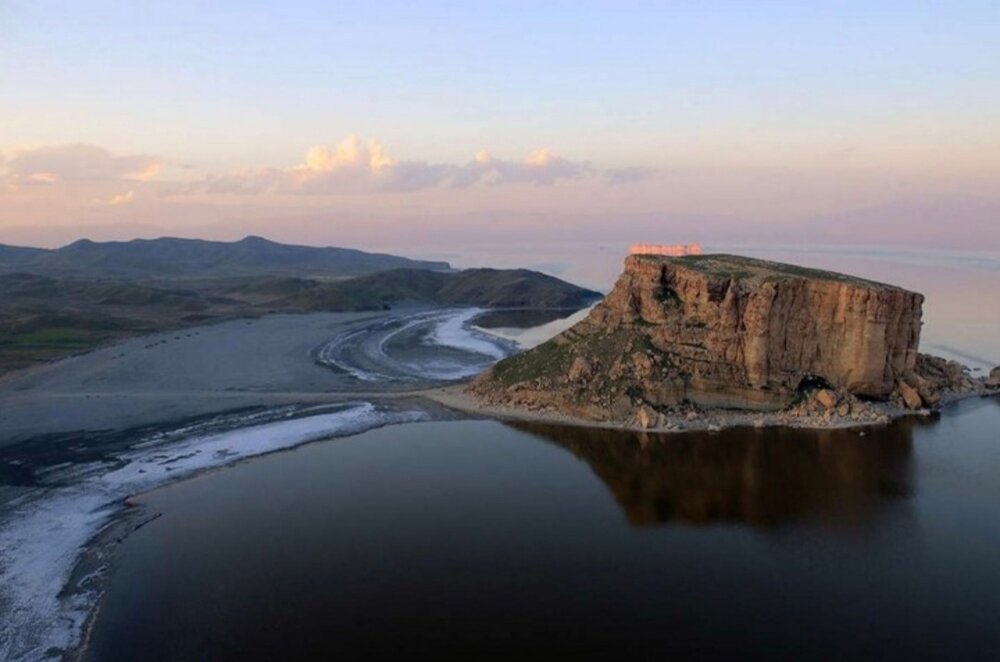Lake Urmia level declines by 30cm in Q1

TEHRAN – The water level of Lake Urmia has decreased by 30 centimeters in the first three months of the current [Iranian calendar] year (March 21-June 21) compared to the same period last year.
Due to the decrease in rainfall over the last two years, this catchment is experiencing a decrease in water level again, Ali Soltanpour, director of the hydrography of the National Cartographic Center said.
A study of Lake Urmia over the past three decades shows that the level of the lake has increased significantly in the early 1990s so that in 1995, it reached 1278.5 meters and many urban and coastal infrastructures were threatened.
After this time, the water level of Lake Urmia gradually dropped due to reduced rainfall and water entering the lake, so that during 3 years, the lake level decreases by about one meter, he added.
According to Soltanpour, since 1998, the lake continued to shrink more rapidly and for 4 consecutive years, the level reduced by another 3.5 meters reaching 1274 meters in 2002.
In 2017, the level even declined to 1271 meters. However, increased rainfall caused the lake level to rise by more than one meter in only several months and exceed 1272 meters.
The Lake Urmia shrank by 30 cm in the first three months of this year compared to the same period last year, due to reduced rainfall and increased evaporation, he lamented, ISNA reported on Wednesday.
Pointing out that since the last two years, the lake has been experiencing a downward trend, he stated that lakes, because they are enclosed water bodies, are therefore affected by climate change.
Sustainable development means replacing harvested resources, but the current situation of the lake shows that sustainable development has not been pursued in this region and other similar areas, and we have damaged the existing resources in the country so that natural resources have not been able to cope with the existing problems, he lamented.
Earlier in July, Omid Yousefi, head of the wildlife surveillance of West Azarbaijan’s department of environment, stated that the population of flamingos in Lake Urmia National Park has decreased by 30 to 35 percent due to the lack of proper living conditions, mainly as a result of the lake’s high salinity.
Noting that this year, 35 to 40 thousand flamingos were counted in Lake Urmia islands, he highlighted that in recent years, the lake was host to 50 to 60 thousand flamingos, which significantly dropped this year due to lack of living conditions and high salt concentration.
According to field studies, the population of birds in this habitat has decreased significantly.
Lake Urmia condition
Shared between West Azarbaijan and East Azarbaijan provinces in northwestern Iran, Lake Urmia, was once the largest salt-water lake in West Asia. It was home to many migratory and indigenous animals including flamingos, pelicans, egrets, and ducks, and attracted hundreds of tourists every year who had bathed in the water to take advantage of the therapeutic properties of the lake.
However, decades of long-standing drought spells and elevated hot summer temperatures that speed up evaporation as well as increased water demands in the agriculture sector shrank the lake drastically. In 1999 the volume of water which was at 30 billion cubic meters drastically decreased to half a billion cubic meters in 2013. Moreover, the lake surface area of 5,000 square kilometers in 1997 shrunk to one-tenth of that to 500 square kilometers in 2013.
Lake's surface area has reached up to 2,917 square kilometers, indicating 1,582 square kilometers increase in comparison to 2013 when the Lake Urmia Restoration Program began.
The level of Lake Urmia has reached 1,271 meters, which indicates an increase of over 1.39 meters compared to the lowest volume recorded. However, it still needs 9.5 billion cubic meters of water to reach its ecological level.
The above normal levels of rain came to help conservation measures to preserve Lake Urmia, but, this year, the drought and low rainfall are threatening the lake again.
FB/MG
